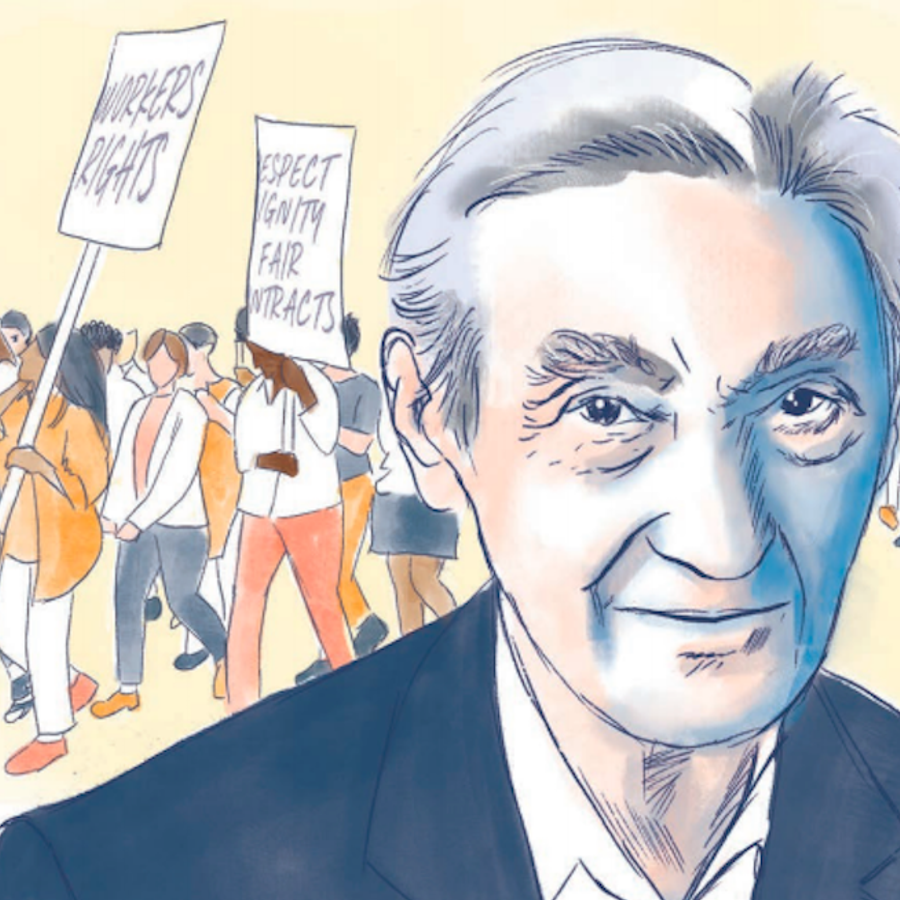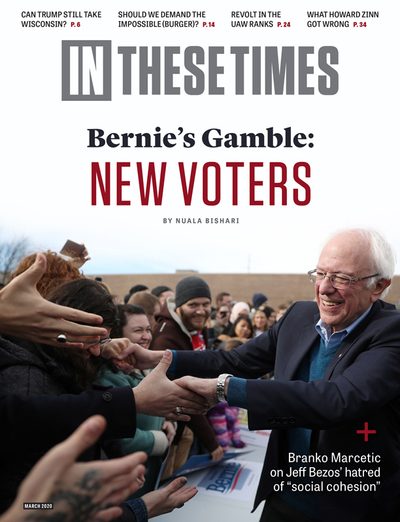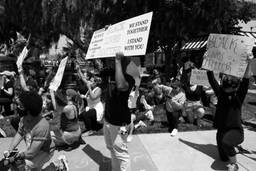What Howard Zinn Got Wrong
The problem with Zinn’s work is that it fails to offer an honest account of how political change actually happens.
Kyle Williams

Howard Zinn’s many contributions to the American Left make his sins as a scholar forgivable — such is the usual (and understandably sympathetic) critique of this icon of revisionist history. But now, on the eve of the 40th anniversary of A People’s History of the United States—with more than 2.5 million copies in print and its influence continuing to grow — readers may want to reexamine how Zinn delivers his message.
Zinn earned his critical view of American power after dropping explosives and napalm over France and Central Europe from B-17 bombers during World War II. Back home, he went to college through the G.I. Bill and studied history at Columbia University, the base of towering liberal intellectuals like Richard Hofstadter and Henry Steele Commager. In 1959, a year after Zinn finished his doctorate, he published his first and only foray into extensive archival research: LaGuardia in Congress, a conventional monograph on Fiorello LaGuardia’s pre-mayoral career as a congressman in the 15 years leading up to the New Deal.
But if graduate school gave Zinn his credentials, his first teaching position, at the historically black Spelman College, gave him his vocation. In the late 1950s and early 1960s, Zinn hosted student activists and participated in desegregation efforts in Georgia, Mississippi and Alabama. Working with the Student Nonviolent Coordinating Committee, Zinn observed registration drives in the South and wrote about the civil rights movement for sympathetic periodicals like The Nation, earning himself an FBI file in the process. Zinn’s role in student activism led the Spelman administration to fire him (not the last time Zinn ran into problems with university administration), and he took a position in the department of government at Boston University, where he stayed for nearly 25 years.
Was Zinn an activist or a historian? He was not alone in challenging the dichotomy. Like historian and In These Times founder James Weinstein, Zinn was a bit older than many of the activists of the New Left, but he nevertheless belonged to a movement of historians who took Van Wyck Brooks’ ideal of a “usable past” as a mantra for their scholarship. Young historians of the Left defined their work in deliberate opposition to what they thought of as detached liberalism and superficially objective history. Instead of merely interpreting the past, these historians wanted to change the present.
Zinn described his ideal as “value-laden historiography” to sharpen popular perceptions of “how bad things are for the victims of the world.” The historian’s job was to retell the official history (as written by the victors) instead as a story of the oppressed — and wake people out of their complacent slumber in the process.
Zinn was not alone in his belief that historical narratives should provoke change, but he broke with other leftists of his generation (including Eugene Genovese, a Marxist historian of slavery) through his strong commitment to history as a way to move people forward. For Zinn, this goal supplanted loyalty to any ideology or professional norm. Because the stakes were so high, he thought there was no time to waste.
As the first edition of A People’s History, published in 1980, insisted, there was no such thing as value-free history — all history advocates one perspective or another; his history advocated for the 99% against ruling elites, from colonialism to the present day, centered on the plight of the marginalized and the resistance of the powerless.
The National Book Award finalist stood as an antidote to conventional school textbooks that left out social movement figures and events that cast the political establishment in a bad light. “It became clear to me,” Zinn said, “that the really critical way in which people are deceived by history is not that lies are told, but that things are omitted.”
Since its publication, A People’s History has had multiple new editions and spinoffs, a rare feat for any historian and especially for one who possessed no interest in telling stories about founding fathers or presidents. Zinn’s narrative not only introduced many people to a critical perspective on U.S. history, but became an invitation to join the resistance. The book’s influence is undeniable.
The problem with Zinn’s work, however, is that it sometimes tries so hard to assault our complacency that it fails to offer an honest account of how political change actually happens.
At Zinn’s hand, the powerless are one-dimensional victims with purity akin to formulaic Christian martyrs. Heroic social movements are so egalitarian and idealistic that they never actually succeed; temporary victories are simply used to build tension before an inevitable defeat.
Consider how Zinn treats the Populist revolt of the late 19th century. A democratic movement of black and white farmers, the Populists supported rural Americans against the emerging corporate-financial system, from Wall Street and London to small-town merchants in Texas and North Carolina. Along with urban movements like the Knights of Labor, the Populists campaigned with far-reaching reform policies that included the regulation of public utilities and transportation, a democratic and decentralized financial system, and labor protections. The agrarian radicals of the Farmers’ Alliance (and, subsequently, the People’s Party) formed cooperative organizations and ran candidates for national office in the 1890s. With William Jennings Bryan on a fusionist ticket, the People’s Party won some local and congressional races, but dramatically lost in 1896 and dissolved shortly thereafter.
Populists saw their failure — and the 1896 victory of business ally President William McKinley — as a tragedy, and many historians have since agreed. But electoral politics is just one part of American political history. Many of the ideas the Populists conceived or rallied around — from antitrust and interstate regulation to a decentralized financial system and others — did not simply disappear. These policy proposals still exist in modified forms. The legacy of organized farmers remained a persistent force in American politics for national control over economic structures. The continued relevance of Populism can be found, among other places, in the small oil towns of early-1900s Kansas or the urban history of Progressive-era Portland, Ore.
In Zinn’s narrative, however, these local and partial victories, made complex by the twists and turns of history, are irrelevant; the story that matters is one-dimensional and (primarily) electoral. The Populists were defeated by the corporations and the press. “Even the hint of Populism” could not be tolerated, Zinn wrote, “and the big guns of the Establishment pulled out all their ammunition, to make sure.” Before any consideration of the Populist legacy, Zinn has already left the scene for Wounded Knee (the “climax to four hundred years of violence that began with Columbus”) and the Spanish-American War (“a way of drowning class resentment”).
Consider, for a moment, labor action during the Great Depression: A million and a half workers went on strike in 1934. In Zinn’s telling, all they got for their trouble was the crushing machinery of the state through a mobilized National Guard and a pacified AFL-CIO. (No serious consideration is made of the significant Democratic gains in that year’s Congressional election or the passage of the National Labor Relations Act the following year.) As for the New Deal, though the Roosevelt administration stands today as inspiration for the left wing of the Democratic Party, Zinn says there is little to be learned except that “capitalism remained intact.”
Zinn is on his strongest footing as a historical narrator in his discussion of the civil rights and anti-Vietnam War movements, but even there the rise and development of social movements is excluded for a parade of protest stories that have been mostly stripped of context. And by the mid-1970s, “the system” went back to work controlling people once again.
All histories, of course, omit some facts and details and rabbit holes, but A People’s History focuses almost exclusively on victimization and tragedy. Zinn’s history, though brilliant with pathos and storytelling, ultimately presents an unusable past; it too often fails to consider the change that occurs through untidy and often disappointing compromises, human longing, unintended consequences and surprising moments of advantage.
Like historical change itself, the value of historical scholarship is often unexpected. As in much of the best scientific research, the historian resists the urge to make their writing overly practical or immediately applicable to the needs of the present in favor of following the slow and often frustrating path of the research process. This process frequently results in unexpected twists and new and sometimes inconvenient conclusions, providing fresh insights into change.
Zinn’s success had an unintended consequence itself: A People’s History quickly moved out of the typically small environs of a radical academic/activist and became an international sensation. Its essential message, that American history is a long story of powerful elites dominating common people, counter-balanced the cultural conservative embrace of American exceptionalism, which gained special prominence in the post-Reagan years. Zinn’s book became a lightning rod in the culture wars over public school curricula, and Republicans in states like Indiana and Arkansas have repeatedly tried to ban the book in schools.
Understandably, the Left has rallied around A People’s History and the book continues to be regarded among some in the activist community as a requisite, if somewhat dated, statement of America’s disordered past.
The rhetorical battles of the culture war rarely lend themselves to careful reflection, and there are good reasons to put A People’s History away. Moreover, much of the scholarship Zinn relied on has itself been revised. Many of the insights and stories that Zinn collected have made their way into contemporary textbooks that are widely available and serve as good alternatives to the right-wing textbooks that Texas curriculum committees continue to insist upon. His perspective is palpable as a member of a leftist movement that was in quick retreat on the verge of the Reagan Revolution and the decline of New Deal liberalism.
Today, we occupy a much different political scene. The social democratic ideas inspired by the New Deal, Populist and social movement traditions are once again popular and stand to influence public policy in significant, immediate ways. Zinn is no longer enough. We need new histories that are clear-eyed about the challenges of creating positive political change in a moment when the Left is poised no longer to sit on the margins of politics.





